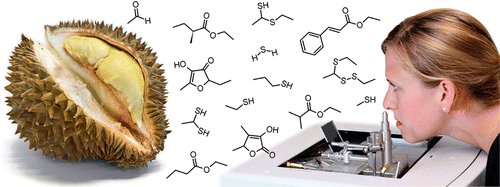Scientists sniff out the substances behind the aroma in the 'king of fruits'

The latest effort to decipher the unique aroma signature of the durian—revered as the "king of fruits" in southeast Asia but reviled elsewhere as the world's foulest smelling food—has uncovered several new substances that contribute to the fragrance. The research appears in ACS' Journal of Agricultural and Food Chemistry.
Martin Steinhaus and colleagues explain that durian, available in Asian food shops in the United States and elsewhere, has a creamy yellowish flesh that can be eaten fresh or used in cakes, ice cream and other foods. Some people relish the durian's smell. Others, however, regard it as nauseating, like rotten onions. Past research identified almost 200 volatile substances in durian. Lacking, however, was information on which of those make a contribution to the characteristic durian smell. The authors set out to identify the big chemical players in the durian's odor signature.
In doing so, they pinpointed 41 highly odor-active compounds, 24 of which scientists had not identified in durian before. Among the most prominent were substances associated with fruity, sweet, sulfurous and oniony smells. The oniony smelling odorants belonged to a compound class that had rarely been found in food before. Four of the newly discovered chemical compounds were previously unknown to science.
More information: "Characterization of the Major Odor-Active Compounds in Thai Durian (Durio zibethinus L. 'Monthong') by Aroma Extract Dilution Analysis and Headspace Gas Chromatography-Olfactometry" J. Agric. Food Chem., 2012, 60 (45), pp 11253–11262. DOI: 10.1021/jf303881k
Abstract
An aroma extract dilution analysis applied on the volatile fraction isolated from Thai durian by solvent extraction and solvent-assisted flavor evaporation resulted in 44 odor-active compounds in the flavor dilution (FD) factor range of 1–16384, 41 of which could be identified and 24 that had not been reported in durian before. High FD factors were found for ethyl (2S)-2-methylbutanoate (fruity; FD 16384), ethyl cinnamate (honey; FD 4096), and 1-(ethylsulfanyl)ethanethiol (roasted onion; FD 1024), followed by 1-(ethyldisulfanyl)-1-(ethylsulfanyl)ethane (sulfury, onion), 2(5)-ethyl-4-hydroxy-5(2)-methylfuran-3(2H)-one (caramel), 3-hydroxy-4,5-dimethylfuran-2(5H)-one (soup seasoning), ethyl 2-methylpropanoate (fruity), ethyl butanoate (fruity), 3-methylbut-2-ene-1-thiol (skunky), ethane-1,1-dithiol (sulfury, durian), 1-(methylsulfanyl)ethanethiol (roasted onion), 1-(ethylsulfanyl)propane-1-thiol (roasted onion), and 4-hydroxy-2,5-dimethylfuran-3(2H)-one (caramel). Among the highly volatile compounds screened by static headspace gas chromatography–olfactometry, hydrogen sulfide (rotten egg), acetaldehyde (fresh, fruity), methanethiol (rotten, cabbage), ethanethiol (rotten, onion), and propane-1-thiol (rotten, durian) were found as additional potent odor-active compounds. Fourteen of the 41 characterized durian odorants showed an alkane-1,1-dithiol, 1-(alkylsulfanyl)alkane-1-thiol, or 1,1-bis(alkylsulfanyl)alkane structure derived from acetaldehyde, propanal, hydrogen sulfide, and alkane-1-thiols. Among these, 1-(propylsulfanyl)ethanethiol, 1-{[1-(methylsulfanyl)ethyl]sulfanyl}ethanethiol, and 1-{[1-(ethylsulfanyl)ethyl]sulfanyl}ethanethiol were reported for the first time in a natural product.
Journal information: Journal of Agricultural and Food Chemistry
Provided by American Chemical Society


















